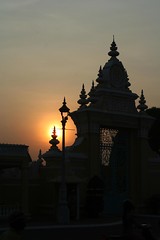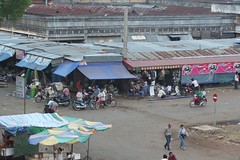
Click photo to see slideshow
or here for all Phnom Penh
pictures
Getting to Cambodia from Bangkok on land is sort of a painful adventure, from what I’ve heard. Guide books and weathered backpackers advise against taking the minibus service to Siem Reap, the gateway to Angkor, offered by many Bangkok hotels and guesthouses. Apparently, the “direct” minibus deal is a major scam. The journey takes the whole day and the weary backpackers are dropped late at night at a commission-paying hotel, when they are too tired to set off and look for another guesthouse. A better alternative is to take public transportation to the Thailand-Cambodia border and arrange your transfer to Siem Reap once you crossed - there is no lack of options on the Cambodian side. Even then, the journey would not be much faster, since the road leading from the border to Siem Reap is in very poor shape. Conspiracy theory pundits maintain that the road is kept purposely in this state of disrepair, in order to bolster business for the only airline that links the two places, Bangkok Airways. Allegedly, Cambodian government officials receive solid kickbacks in exchange for keeping their eyes closed and allowing the status quo to continue. But that’s just a story… I’m sure that the money we paid to Bangkok Airways to fly us to Cambodia, about $200 per person for a 35-minute flight, will be used for a noble cause…
After exhausting ourselves scampering through the ruins of Angkor, the obvious next step was to travel to Phnom Penh, the capital of the country, the central hub where all roads lead to anyway. Luxury buses (luxury meaning that they have AC and a toilet) between Siem Reap and Phnom Penh take about 5 hours and cost $8. The road is paved and the ride uneventful.
Phnom Penh, the largest town in Cambodia, still has the air of a sleepy colonial river outpost, boasting a nice French quarter with many renovated, charming buildings. Between 1975 and 1979, during the genocidal Khmer Rouge regime, the city was almost completely abandoned; the population was evacuated and sent to remote villages and reeducation camps. Its residents were labeled enemies of the people, unfit and unworthy to live in the new agrarian republic of Kampuchea; many were eventually killed. The infrastructure gradually collapsed; the plumbing system, unused for too long, decayed and broke down. Rebuilding efforts started soon after the demise of the communist regime, with the gradual return of the population. Today the town looks pretty good, considering what it’s gone through in the past. Business is booming; tourists, foreign NGO workers, and even Cambodians fill the fancy restaurants and cafes along the river; renovation projects and construction work are underway in many parts of town. Yet as charming as Phnom Penh is, it’s nothing to fall in love with. After a few uneventful days, which we spent mostly eating and watching TV in our $15 air-conditioned room at the “OK Guesthouse” - a favorite backpacker’s hangout - we moved on… but not before a last-day extravaganza, spending $50 for Spanish tapas and a bottle of red wine at one of the finest restaurants in town.
Since there wasn’t much else to see in Cambodia, we continued creeping our way toward Laos. There aren’t any luxury liners on that route; we had to take a mosquito-infested local bus that stopped in every village. It wasn’t very cheap (at least for us foreigners) - $12 and about 9 hours will bring you not quite to the border, but to Stung Treng, the closest town, where bus services end. Locals don’t cross the border often, and when they do, they are more likely to be seen on motorbikes loaded with bags and crates in a precarious balancing act. Various Phnom Penh guesthouses that provide bus tickets to backpackers sell transportation all the way to the Laos border, without volunteering the information that you have to spend the night in Stung Treng. But you have no choice, the border closes early. In Stung Treng, another $13 will get you a ticket involving two river crossings and two road transfers, all the way to Four Thousand Islands - the backpacker’s haven on the Mekong River in the south of Laos. Surprisingly, the suspicious-looking guy who sold us this deal accepted the Phnom Penh-to-Lao-border ticket that one of the foreign travelers had; he only paid $8.
The shipping of backpackers into Laos is like a family affair around here; guesthouses, bus companies, ferry operators, border guards - everybody seems to get a piece of the pie. Things works on the “Cambodian hour,” which is not unlike the Mexican hour; you must double the time they give you, and add one hour here or there to account for the unavoidable delays. We were told we would leave at 7:30AM, but ended up on the bus around 10. No one would tell us - five increasingly annoyed falang backpackers - what was going on, or when we would finally leave. Straight answers are not the norm here; admitting failure would mean losing face. Magically, when you demand explanations or try to negotiate for a better price, nobody speaks English anymore. But maybe there was a problem on that day and maybe they did usually leave at 7:30… in any case we made it to the border, where a larger group of tourists going the other way was waiting for the bus to take them into Cambodia.
Crossing the border was a breeze... a money-smelling breeze. At the border post on the Cambodia side, a simple wooden shack on the side of the road, the surly guard stamped our passports with the exit visas. “One dollar each” he said, in a flat, matter of fact voice. I know it’s never wise to argue with border officials in third-world countries, but I couldn’t help asking “Why?” “Overtime work,” the answer came. “It’s Sunday.” We smiled and paid. Later Angela told me she was burning to say “No problem, we come back tomorrow,” just to see how they take it. I suspect stamping passports would be considered overtime work not only on weekends, but also during breakfast, lunch and siesta and in general, whenever tourists happen to arrive.
A van was waiting for us on the other side of the barrier, confirming that we hadn’t been scammed after all. A few hundred meters farther, at the Laos border post, we showed our visas, which we had obtained in advance through an agency in Bangkok, and filled our entry cards. “Two dollars each,” the guard said, holding my passport in his hand. “Why?” “Overtime work. It’s Sunday.” I paid without saying a word, but at the same time I was thinking that somebody should tell those suckers on the Cambodia side that they have to adjust the overtime fee, because their smarter Lao colleagues are making double the money for the same work…
Posted from Vientiane, Laos.





1 comment:
I love the bit about the border crossings. Way to be cheeky to them, glad they didn't mind!
Post a Comment